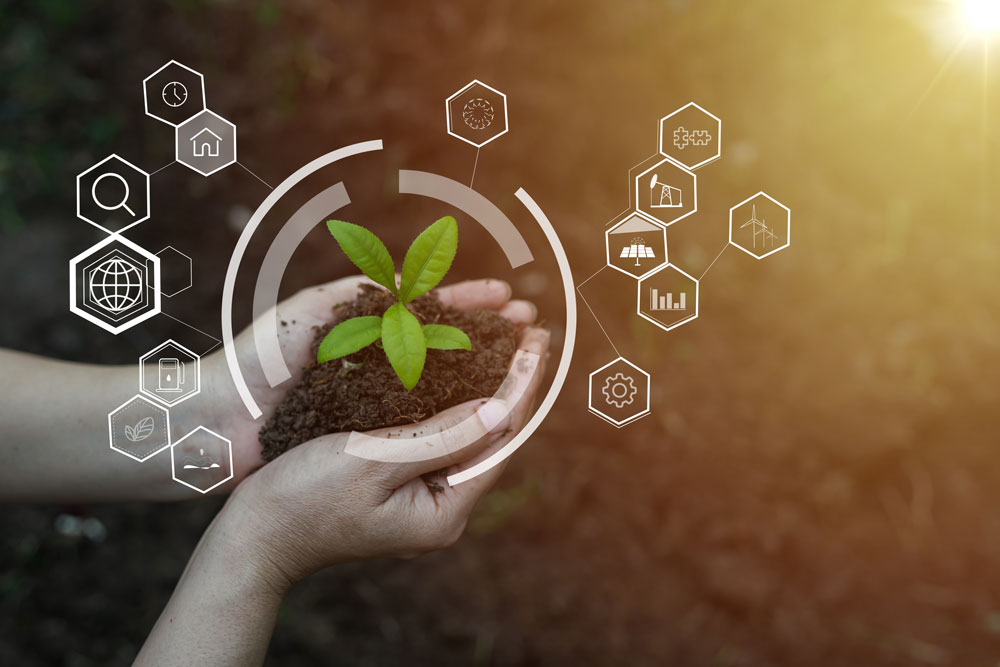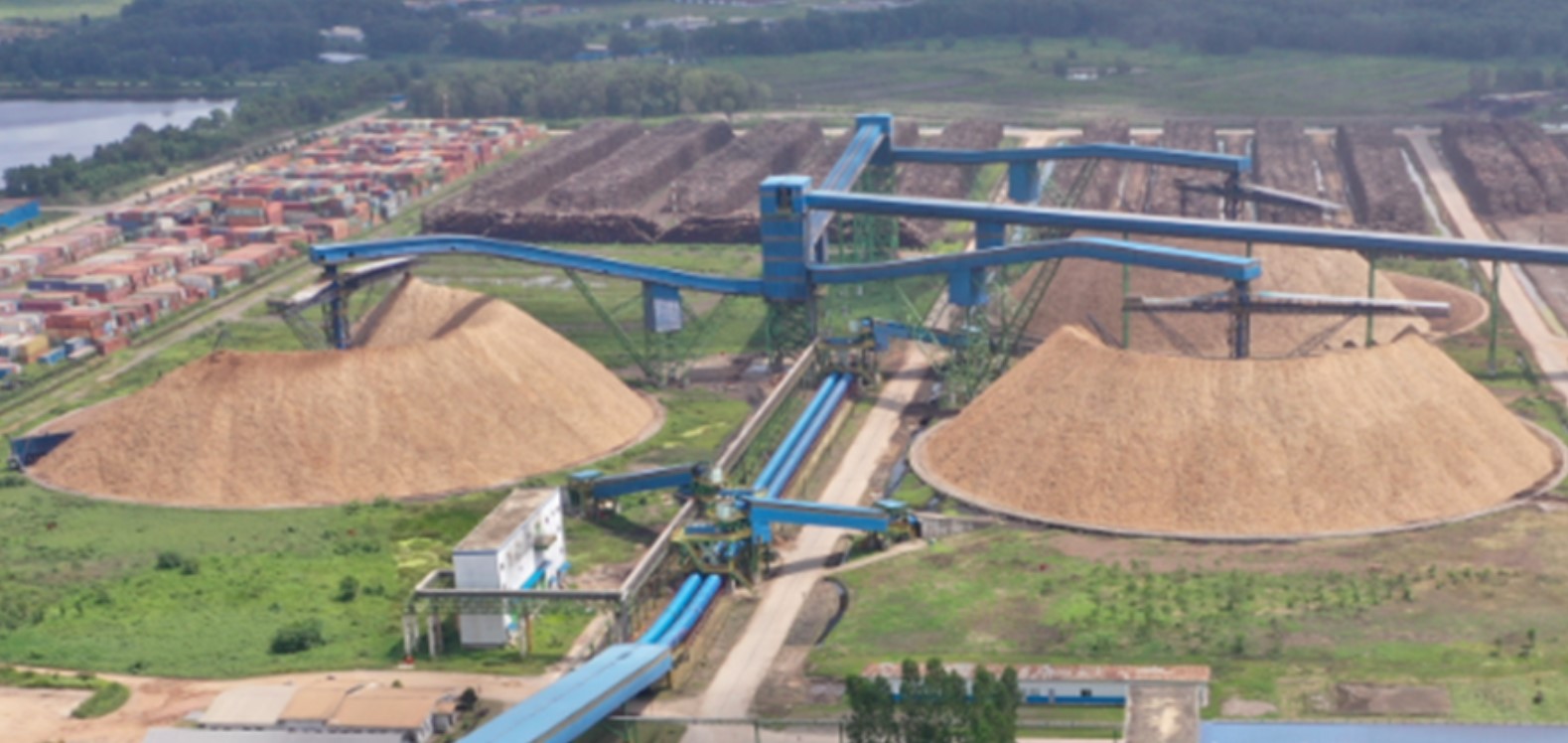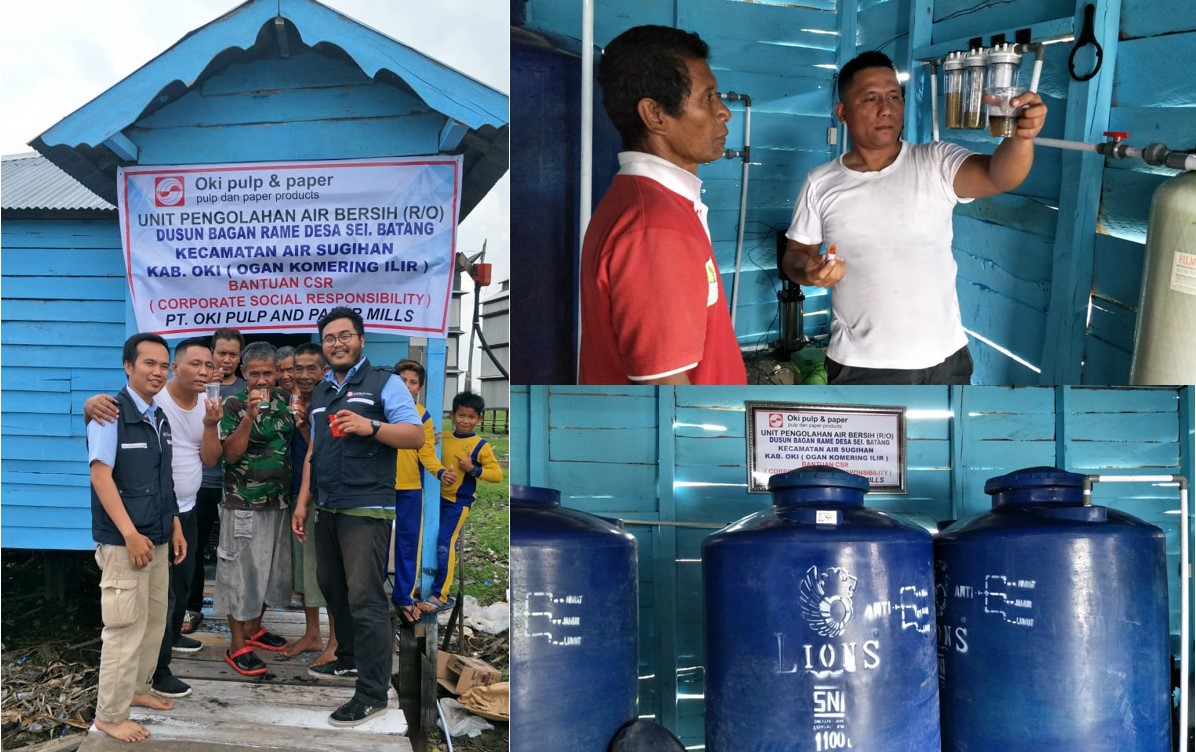
OKI's management is committed to support the implementation of responsible Environment, Social and Governance (ESG) in its operations. This commitment is embodied in various integrated policies and management systems, in accordance with applicable laws and standards. Regarding sustainable environmental management, the company's commitments include:
- Implementation of environmental management systems (ISO 14001) and energy management (ISO 50001).
- Enforcement of the 4R principles (Reduce, Reuse, Recycle and Recovery) for waste management and control of the quality of the wastewater produced.
- Quality control of Green House Gas (GHG) and non-GHG emissions with energy efficiency initiatives and increasing the ratio of renewable energy use.
- Application of efficient use of resources, application of Life Cycle Assessment (LCA) and the concept of Circular Economy (Circular Economy).
- The use of safe chemicals aims to protect the health of workers, the community and the surrounding environment.
To follow through on this commitment, OKI is making efforts to implement environmental programs in a sustainable manner. These programs are prepared by taking into account the targets and deadlines of the Sustainable Roadmap Vision (SRV) 2030 (among others: 30% reduction in carbon intensity, 50% increase in renewable fuels, 25% reduction in energy intensity, 30% reduction in air intensity, 30% emission COD is lower than government regulations, zero waste to Final Disposal Sites (TPA) and Government requirements based on applicable regulations. The action plan for implementing each program is evaluated periodically to ensure that the environmental program is running effectively. One example of a program being implemented is the Company Rating Assessment Program in Environmental Management/PROPER (Public Disclosure Program for Environmental Compliance), organized by the Ministry of Environment and Forestry of the Republic of Indonesia. OKI succeeded in achieving a score of 100% compliance with environmental regulatory requirements. The assessment is carried out every year and is processed every time there is a new regulation from the government.
Several environmental certificates obtained, such as ISO 140001, ISO 50001 and the Green Industry Certificate from the Ministry of Industry of the Republic of Indonesia, show that OKI is doing its best to handle environmental problems in its daily operations.
Apart from that, OKI also requires its workers to take part in the New Employee Orientation (NEO) program organized by the Human Resources (HR) Academy, where one of the materials presented is environmental management in operational areas. Periodic refreshment training is provided to workers, covering Environment, Health and Safety material. HR Academy is also committed to meeting worker training needs in accordance with certification required by regulations and other competencies, including in the field of environmental management such as Life Cycle Assessment (LCA), ISO Management System, Water Pollution Control Manager (MPPA), Person in Charge of Air Pollution Control (PPPU), B3 Waste Management (PLB3) and others, specifically for workers whose duties are related to environmental management.
Regarding the waste water effluent management target, OKI is committed to fulfilling the requirements of laws and regulations regarding the fulfilment of the effluent quality threshold value which must be maintained. OIC is also working towards a target and deadline of 30% lower COD emissions than government regulations in SRV 2030.
Effluent Management
To reduce the amount of waste water effluent, OKI has made several efforts by implementing the 3R (Reduce, Reuse and Recycle) concept. Several efforts have been implemented including:
- Closed loop system for managing white water in the fiberline process.
- Reusing waste water in the log washing process for reuse in the washing process.
Meanwhile, to meet the waste water effluent threshold value, one way is by trying to maintain the Dissolved Oxygen value in the Waste Water Treatment Plant (WWTP) process unit. To prevent the presence of deposits that can hinder the aeration process, optimal aeration performance is required, so that OKI innovates by replacing the method of use that prevents the build-up of deposits on the diffuser and makes it easier for the operator to perform regular cleaning and maintenance of the diffuser.
To prepare for emergency conditions for waste water effluent management, OKI has a team that is competent in incident handling readiness and emergency response conditions. The concept of Non-Conformity Report (NCR) is applied to investigate and determine effective actions in dealing with an environmental incident. There are procedures for managing incident handling and emergency response systems, including Emergency Response Preparedness procedures. The procedure includes a system for investigating (incident management system using SAP), determining corrective actions to be taken if an environmental incident occurs. The procedure also regulates the flow of information and reporting in accordance with the structure of the emergency response team, so that handling can be carried out effectively and efficiently.
The emergency response team is provided with periodic training including incident handling and emergency response simulations in areas with a high potential for environmental incidents to occur. Preventive measures are also part of incident handling procedures.
Water Risk Management
To improve the availability and quality of water related to the production process, OKI conducts a water scarcity assessment. One of the efforts made based on the results of the assessment is to move the water intake from water originating from the Sugihan area to the Padang River area, taking into account the depth, quality and availability of water as well as climatic influences.
In the future, OKI plans to conduct a more in-depth water scarcity assessment to ensure the sustainability of water availability for a long period of time. This is in line with efforts to meet the target and deadline of 30% reducing water intensity in SRV 2030.
Hazardous Waste Management
OKI continues to strive to reduce the volume of B3 waste generation. Efforts were made to optimize pulp and tissue production operations to reduce the use of chemicals by 14%. The reduction in the use of chemicals accompanied by the implementation of a chemical packaging return program has had an impact on reducing the amount of chemical packaging waste. Through efforts to reduce chemical packaging waste, in 2022 OKI will be able to reduce the generation of B3 packaging waste by up to 51% of the total reduction in the previous year.
As part of efforts to fulfil targets and deadlines that are in line with SRV 2030, namely zero waste to final disposal sites/TPA and in accordance with applicable environmental regulatory requirements, OKI controls the amount of waste produced and the amount of waste managed through the waste balance calculation method. Apart from that, controlling the reduction in B3 packaging waste includes monitoring the use of chemicals and selecting safe types of chemical packaging, aimed at protecting the health of workers, the community and the surrounding environment.
Non-GHG Air Emission Program
OKI is an integrated pulp mill that has several processes, including electricity/steam generation. This process requires burning fuel, resulting in emissions. All emissions are monitored manually and automatically. Manually, OKI carries out periodic tests to measure the quality of emissions from internal and external parties. Automatically, OKI uses a Continues Emission Monitoring System (CEMS) which monitors emissions in real-time and continuously. All quality parameters, including non-GHG air emissions such as SOx, NOx, dust/particulates, and turbidity, are accurately identified with CEMS technology. OKI also carries out regular maintenance on CEMS equipment to ensure the equipment functions optimally.
OKI has several programs that include technologies to reduce non-GHG air emissions. OKI replaces fossil fuels that produce more SOx and NOx with renewable biomass fuels. Emissions resulting from burning biomass will have less SOx and NOx. OKI also uses a scrubber system in the OKI pulp making process. The scrubber can absorb non-GHG gases in the bleaching fiberline area. Another technology that OKI applies is an electrostatic precipitator called an Electrostatic Precipitator (ESP). ESP captures particulate matter from the combustion process in the furnace before it escapes into the atmosphere.
The OIC sets targets and deadlines for improving the quality of non-GHG emissions based on applicable regulations. OKI has implemented an Environmental Monitoring Plan (RPL) as OKI's internal control for emissions and waste. OKI continues to strive to update modifications and emission control technology that can improve OKI's environmental performance.
Water Management Program
OKI has made several efforts to reduce raw water consumption in its production process, including by:
- Reusing white water in a pulp drying machine which has succeeded in reducing the intensity of water use for the needs of the fiberline production process from 2.57 m3/ADT to 2.31 m3/ADT.
- Utilizing blow down water for reuse as top up water in cooling towers, which has succeeded in reducing the intensity of water use in cooling tower power plants 1.87 by 1.72 m3/ADT.
- using water from the Padang River which has a better quality so that it can reduce raw water consumption for production needs from 7 million m3/month to 5.8 million m3/month.
This is in line with efforts to meet the target and deadline of 30% reduction in water intensity in the SRV 2030 and comply with applicable environmental regulatory requirements.
Renewable Energy Program
OKI has a high commitment to sustainability and reducing the carbon footprint, which is demonstrated by a comprehensive decarbonization work plan. Being located in a remote area, far from conventional electricity networks, has encouraged OKI to proactively fund its energy needs so that it can use renewable energy by operating power and steam plants. OKI's main sources of energy include bark and black liquor as biomass.
It is noteworthy that OKI's sustainability efforts include building a factory that uses renewable energy, thus strengthening the OKI factory's status as an integrated pulp and paper facility with an independent renewable energy source. This innovative approach eliminates the need for Renewable Energy Certificates (RECs) or other Virtual Power Purchase Agreements (PPAs), as the use of renewable energy in OKI's operational areas meets more than 97% of OKI's energy needs.
Responsible management of energy resources includes a key element in OKI's high pressure steam production. This important component makes a major contribution to avoiding carbon emissions, preventing the release of 2,417,885-tons of CO2e every year. OKI's emphasis on biomass utilization makes OKI an example of a pulp and paper facility with low carbon emissions, which significantly reduces adverse environmental impacts.
To ensure a reliable biomass supply, OKI has taken proactive steps by combining Empty Fruit Bunch (EFB) and saddled palm fiber from nearby palm oil plantations. These efforts have produced impressive results, manifesting in a 23% reduction in carbon emissions in 2022 compared to the previous year. In addition, the OKI estimates an additional reduction of 48% in 2023, this shows the consistent implementation of the OKI's commitment to environmental protection responsibilities.
The Recovery Boiler is the main source of high-pressure steam which provides support for around 85% of the total factory needs. This success is quite astonishing because it was achieved simultaneously with the avoidance of carbon of 4,586,994-ton CO2e per year, by using Heavy Black Liquor as a substitute for fossil fuels.
In addition, the use of Bark Gasifier plays an important role in energy efficiency during the Lime Kiln process, which covers about 80% of the total energy consumption so as to minimize consumption of fuel oil. This has an impact on carbon avoidance of 238,128 tons of CO2e per year. OKI remains active in upgrading and expanding its Bark Gasifier usage capacity, with a future target of covering 90% of the renewable energy used in the Kiln Lime process.
OKI's commitment to sustainability is an ongoing journey. OKI continues to look for additional renewable energy pathways, such as exploiting biogas from wastewater effluent treatment and considering the option of Solar PV on the roof outside the operational area, in the future.
In summary, all these efforts confirm OKI's dedication in ensuring the commitment to responsible resource management and minimizing the environmental impact of its operations. This is in line with efforts to fulfil the target and deadline of 50% increase in renewable fuel in SRV 2030.
Supplier Environmental Program
OKI has conducted an evaluation of their pulpwood suppliers for tissue production. This evaluation process was conducted using a tool called Supplier Evaluation and Risk Assessment (SERA) which assess the environmental performance of the suppliers.
Recycled Material Use
To adhere with recycling principles, OKI Pulp and Paper recycles their waste material while maintaining its product quality. The implementation efforts in material recycling include:
- Reusing 100% of reject knots in the chip wood cooking process in the fiberline. Previously, this reuse process was done manually with chip piles. Modifications were made to enable the reuse of reject knots within a closed system.
- Utilizing 76% of Tail Reject (TR) pulp for the brown pulp production in the pulp-making process.

